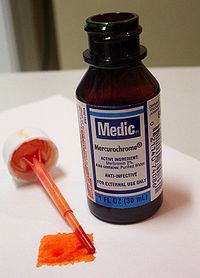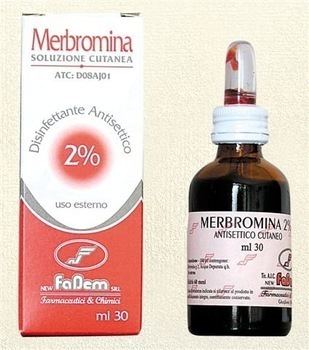Formula C20H8Br2HgNa2O6 Appearance dark green solid | Molar mass 750.65 g/mol | |
 | ||
IUPAC ID dibromohydroxymercurifluorescein | ||
Merbromin (marketed as Mercurochrome, Merbromine, Sodium mercurescein, Asceptichrome, Supercrome, Brocasept and Cinfacromin) is a topical antiseptic used for minor cuts and scrapes. Merbromin is an organomercuric disodium salt compound and a fluorescein. It is readily available in most countries but, because of its mercury content, it is no longer sold in Switzerland, France, Germany, and the United States.
Contents

Uses

Merbromin's best-known use is as a topical antiseptic to treat minor wounds, burns, and scratches. It is also used in the antisepsis of the umbilical cord and the antisepsis of wound of difficult scar formation, like neuropathic ulcers, and diabetic foot sores. When applied on a wound, it stains the skin a distinctive carmine red, which can last up to 2 weeks through repeated washings. It is useful on infections of the finger or toe nails because of its permanence, and lethality to bacteria. It was known in many households as "monkey blood."

The U.S. Food and Drug Administration in 1998 classified merbromin as "not Generally Recognized as Safe" together with a multitude of other active compounds, based on the absence of interest on the part of pharmaceutical companies in funding new studies or updated supporting information, due to the high costs of said studies in comparison to sales, rather than due to being toxic.
In the United States, its use has been superseded by other agents (e.g., povidone iodine, benzalkonium chloride, chloroxylenol). It is still an important antiseptic, particularly in developing nations, due to its “unbelievably low cost.”
Merbromin is also used as a biological dye to mark tissue margins and as a metal dye in industrial dye penetrant inspection to detect metal fractures.
Synthesis
Merbromin is synthesized by combining dibromofluorescein with mercuric acetate and sodium hydroxide or alternatively, through action of the mercuric acetate upon or (combining with) sodium dibromofluorescein. Because of its anionic character, it is chemically incompatible with acids, the majority of alkaloid salts and most local anesthetics.
Mercurochrome
Mercurochrome is a trade name of merbromin. The name is also commonly used for over-the-counter antiseptic solutions consisting of merbromin (typically at 2% concentration) dissolved in either ethyl alcohol (tincture) or water (aqueous).
Its antiseptic qualities were discovered by Hugh H. Young in 1918, while working at Johns Hopkins Hospital as a physician. The chemical soon became popular among parents and physicians for everyday antiseptic uses, and it was commonly used for minor injuries in the schoolyard.
The United States Food and Drug Administration (FDA) moved it from the “generally recognized as safe” classification into the “untested” classification to effectively halt its distribution in the United States on October 19, 1998 over fears of potential mercury poisoning. Sales were halted in Germany in 2003, and in France in 2006. It is readily available in most other countries.
Within the United States, products such as Humco Mercuroclear play on the brand recognition history of Mercurochrome, but substitute other ingredients with similar properties (Mercuroclear: "Aqueous solution of benzalkonium chloride and lidocaine hydrochloride").
The label on at least one brand of the compound listed the ingredients as "dibromoxymercuriflourescein sodium" and alcohol.
